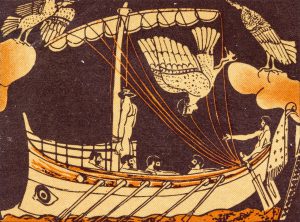I just finished reading Emily Wilson’s translation of The Odyssey. While I have heard that, among purists, this translation is controversial, for me the colloquialisms and interjection of modern idiom made it really engaging and fun to read. Just as interesting as the text itself is Wilson’s introduction, which includes lots of supplemental information and interpretive re-imagining.
She reminds the reader of a central and often overlooked fact of the recounting of Odysseus’s adventures. For anyone familiar with the timeline of the tale, events unfold something like this: First, the Trojan War. Then Odysseus’s long journey back to Ithaca, with stops and encounters along the way that include the Cyclops, the Sirens, Scylla and Charybdis, the sorcerer Circe, and the goddess Calypso (among others). Then, finally, arrival home, where Odysseus must fight suitors who have moved in and are pressuring his wife Penelope to remarry.
It’s an exciting story, filled with action and adventure. So it’s interesting that Homer begins his epic at an unexpected place: Wilson tells us that the narrative begins in media res—“in the middle of things.” We start at the center of the timeline, when nothing much is happening at all. Odysseus is trapped on Calypso’s island, day after day staring out at the sea. Penelope is trapped in the tedium of endlessly weaving and unweaving a tapestry, in a desperate attempt to hold off the men who wish to claim her.
Wilson contends that it is fitting for epics to begin in a barren, lonely place; a desert, if you will. Trial, testing, action and, ultimately, victory all evolve from the time where nothing seems to be going on—or when what is going on seems like just more of the same. May we engage the epic season of Lent with the faith that, wherever we find ourselves when we begin, God stays with us through the deserts before us. The Holy Spirit is present, even when we are not aware of her activity, working always within our travels to bring us closer to our sacred home.




